Cod Is Dead—Is Dogfish the Answer?
With hardly any cod left in the sea, Chatham fisherman Doug Feeney is out to make the dogfish cool enough for New Englanders to eat—and hopes to revive a dying industry along the way. By Ben Goldfarb
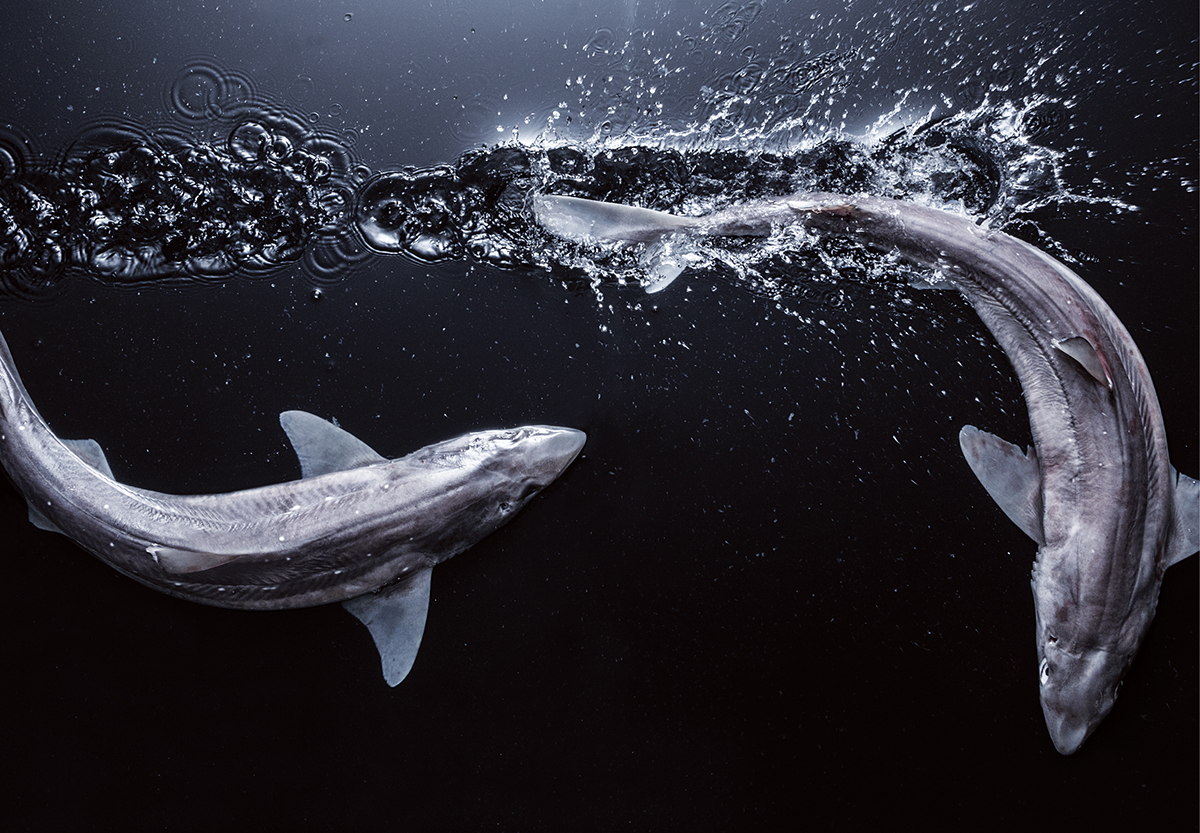
It’s not Jaws—it’s your next dinner. Meet New England’s spiny dogfish. / Photograph by Toan Trinh
On a wind-tossed autumn morning off the Cape Cod coast, the aft deck of Doug Feeney’s 36-foot fishing boat, the Noah, is buried beneath a squirming, slimy, shin-deep layer of sharks.
The Noah’s hauler growls under the weight of the 300-hook long line emerging from the froth-tipped Atlantic. The reek of gasoline mingles with salt. A procession of small gray sharks, each pierced neatly through the jaw by a steel hook, materializes from the depths. Feeney, a lean fisherman whose goatee and hoop earrings lend him a vaguely piratical mien, yanks the sharks from the line with the steady rhythm of an assembly-line worker. A drained cup of coffee perches on the dashboard; James Taylor warbles on the radio.
“Twenty-five years ago we’d catch 10,000 pounds of these things every day,” Feeney shouts over the roar of the engines and “Fire and Rain.” “We’d just throw ’em back over the side.”
Like many Chatham fishermen, Feeney is a jack-of-all-trades. He gillnets monkfish in early spring, he trolls for bluefin tuna in late fall. But no species occupies more of his energy than the spiny dogfish, the dachshund-size shark now piling up on the Noah’s deck. Though the word “shark” conjures visions of the toothy great white, spiny dogfish, the most common shark in the world, bears little resemblance to Jaws. For starters, it rarely grows more than 4 feet long. White freckles dot its slate-colored back and its green eyes glow with an eerie feline light. Stroked head to tail, its skin is almost velvety to the touch.
What Squalus acanthias lacks in fierceness, it makes up for in abundance. From Florida to Maine, populations are flourishing, so much so that the annual quota—the total weight that fishermen are allowed to catch—has increased every year from 2008 to 2015, cresting at a whopping 50 million pounds before dipping to 40 million this year. Such bounty stands in stark contrast to the grim status of Massachusetts’ most iconic fish, the cod, so depleted that quotas have sunk below a meager one million pounds. With the cod industry in a state of collapse, dogfish represent perhaps the best hope for struggling local fishermen. “These guys have been through so many cuts,” says Tobey Curtis, a fisheries policy analyst with the National Oceanic and Atmospheric Administration (NOAA). “When we have success, we want to be able to pay them back.”
Yet the dogfish boom faces obstacles—chiefly, the neglect of U.S. consumers. As the author Paul Greenberg reported in his 2014 book, American Catch, 91 percent of the seafood we eat originates overseas, much of it on farms. Our supermarkets are stocked with shrimp from Thailand, salmon from Chile, and tilapia from China. Although fish-farming techniques in many places are improving, foreign seafood often comes with hidden costs: Some shrimp farms deploy slave labor, many salmon operations pump fish full of antibiotics, and tilapia aquaculture practices in China have been accused of polluting lakes and sickening fish. Meanwhile, a full third of what we catch in American waters gets shipped abroad. “The whole world’s laughing at us,” says Jared Auerbach, founder and CEO of Red’s Best, the Boston-based seafood distributor that buys Feeney’s dogfish. “We’re exporting our great wild fish and importing all their junk.”
Dogfish make a handy poster species for this dilemma. In Europe, the sharks have long been held in high esteem: Order Schillerlocken in Germany, saumonette in France, or fish and chips in England, and you’ll likely be dining on dog. Here in the United States, however, dogfish remain so obscure that a 2015 Bloomberg Businessweek article mislabeled them as an invasive species. Such anonymity is disastrous for business: While cod fetch more than $2 per pound, dogfish rarely earn more than 20 cents—mere pennies above a fisherman’s break-even point.
But Feeney isn’t standing idle in the face of indifferent markets. Over the past several years, he’s launched a multipronged assault on the world’s seafood buyers, promoting his product from collegiate dining halls to local burrito joints to sprawling Chinese convention centers. To dogfish proponents, the humble sharks offer a sort of acid test for America’s seafood future. Can diners be trained to eat a fish they’ve never heard of? Can Cape Cod’s fishermen survive post-cod?
The answer to that question won’t just determine where your fish comes from—it will also shape Feeney’s future. “I have my whole livelihood on the line here,” he says. He’s already invested $15,000 from his savings; whether that investment pays off may well determine his ability to support his young family, particularly his three-year-old son, Noah, the boat’s namesake. “He’s a very special child, an old soul,” Feeney says, his pride tinged with an undercurrent of anxiety. “I wanna give him the same shot I had if he so chooses.” As Feeney motors toward the next long line, the Noah now sitting a smidge lower beneath its cargo, he nods confidently, his brow creased beneath a baseball hat. “I see a future in dogfish, I really do,” he says, almost to himself, as though repeating a mantra. Flecks of blood speckle his sweatpants. “It’s gonna work. It’s gonna have to work. Because there’s nothing else out there.”
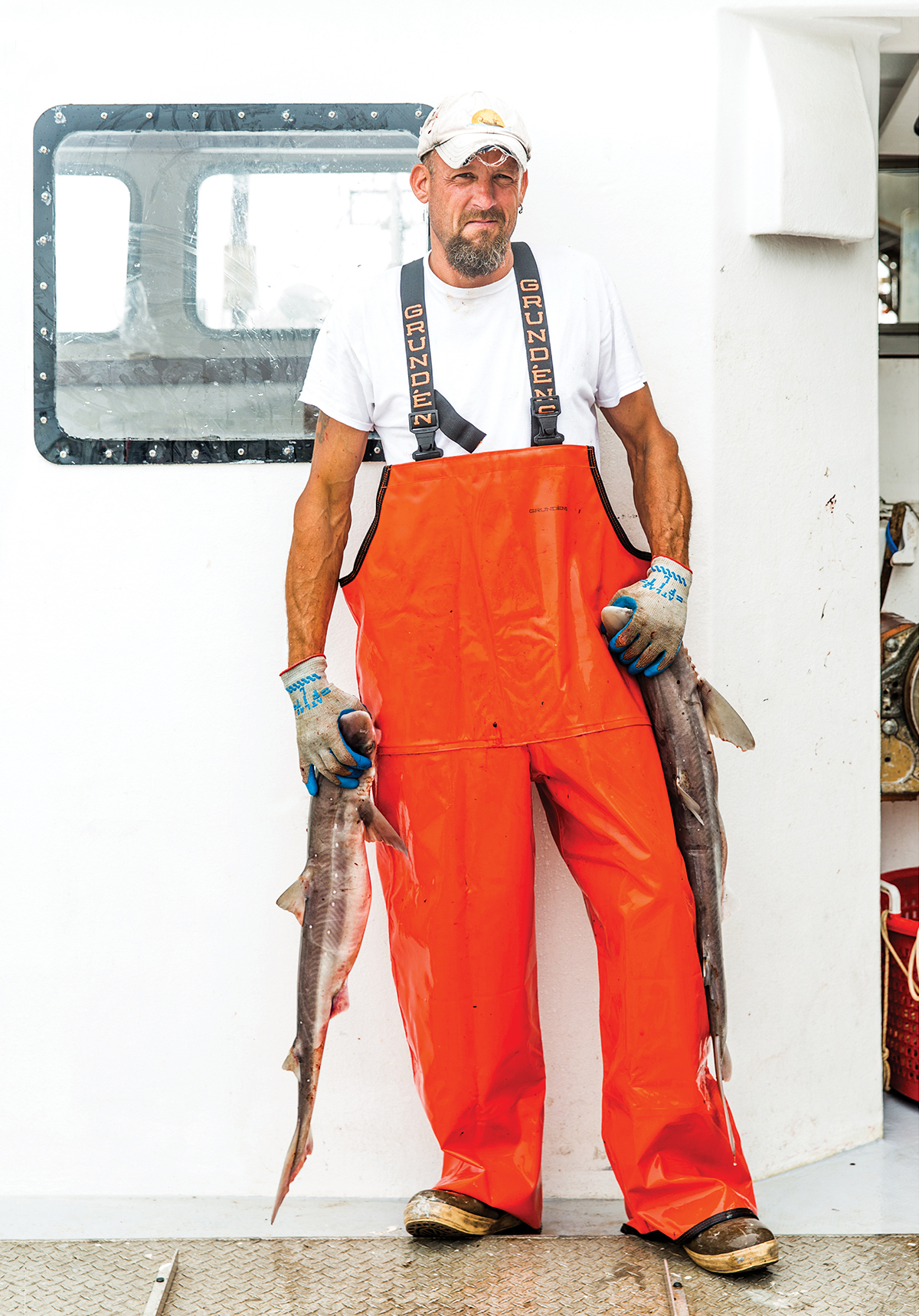
With the lowly but plentiful dogfish, Doug Feeney believes he has the future of the fishing industry in his hands. / Photograph by Greta Rybus
Doug Feeney’s fishing baptism came in the late 1980s, a fleeting moment of optimism before the industry’s crash. Though Feeney didn’t come from a fishing family, his older brother worked on a boat, and Feeney got hooked not long after he turned 15. “The sea stole my heart,” the Yarmouth Port native says. After a six-year Army stint, Feeney moved to Chatham in 1997, crewing aboard a succession of groundfish boats—vessels that pursued bottom-dwelling species such as haddock, flounder, and, especially, cod. He met a Bulgarian barista named Petya and sat in her shop for hours, gulping down coffee after coffee, before he finally summoned the courage to talk to her. They married and bought a house, then a boat. By 2010 Feeney had become a captain himself.
He couldn’t have timed it worse. For generations New England fishermen had built their livelihoods on cod, the bountiful fish that lured Basques and Vikings to the New World, transformed the Colonies into an economic power, and helped launch the American Revolution after the British closed colonists’ offshore fishing grounds in 1775. In the 20th century, however, intense fishing competition and technological innovation—bigger boats, better nets, sonar—demolished stocks and prompted stringent regulations. Fishermen suffered alongside their quarry: Between 2001 and 2011, the number of licensed groundfish boats in the Northeast plunged from more than 1,000 to just 344. Working waterfronts and seafood processing plants shuttered along the New England coast, often replaced by the second homes of wealthy out-of-towners, or by nothing at all. In 2012 the federal government declared the industry a disaster.
But Feeney, a sinewy 45-year-old with the barely contained energy of a coiled spring, isn’t a complainer. Over the years, he’s seen his engine crap out during a hurricane (“Sucked pretty bad”), watched 20-foot waves crash over the Noah’s cabin (“Took it like a champ”), and survived cancer after his fellow Chathamites raised $14,000 for his recovery (“That’s the kind of tightknit community we are here”). Besides, he didn’t have much choice: As a new boat owner, he couldn’t afford to buy or rent the rights to catch cod, which rested mostly in the hands of older fishermen. With cod off the menu, he turned to a fish that had experienced its own roller-coaster ride: dogfish.
The dogfish had once been New England’s most despised sea creature, an alleged nuisance that clogged nets and crowded out more-desirable species. “If John Cabot were alive today, he would not recognize Georges Bank,” Massachusetts Congressman Gerry Studds lamented in 1991. “Instead of a sea swarming with majestic cod, he would find dogfish…. Instead of a fisherman’s dream, he would find a nightmare.” By the mid-1990s, however, Studds’s nightmare had become a thriving—and loosely regulated—export fishery targeted at Europe, whose own dogfish stocks had been devastated by overfishing. But North America’s sharks soon crumbled beneath the pressure. Dogfish give birth to live young after a gestation period of up to two years—among the longest in the animal kingdom. That sluggish reproduction, scientists claimed, was preventing the sharks from replacing their numbers. In 1998 NOAA declared the species overfished, slashed the quota to 4 million pounds, and limited fishermen’s daily catch. Another fishery had apparently gone down the tubes.
Yet by the mid-2000s, fishermen soon began noticing something strange: Dogfish were turning up in big numbers again. In retrospect, the population had likely never dwindled as much as the government feared, and the tough restrictions expedited recovery. More than anything, though, scientists may have underestimated the shark’s resilience. Dogfish travel in packs that sometimes number in the thousands; have Wolverinelike healing powers that help them survive after being caught and discarded; and scarf down anything that fits in their tooth-studded mouth. James Sulikowski, a marine biologist at the University of New England, has found that dogfish are reaching sexual maturity more quickly than in the past, and breed throughout the year. “There’s no time off—as soon as they give birth, they start over again,” Sulikowski says. “They’re like little machines.” The government officially declared the little machines recovered in 2010; today, scientists estimate that the Gulf of Maine contains 23 pounds of spawning dogfish for every pound of cod.
But while Feeney and other fishermen found themselves knee-deep in dogs, they struggled to find anyone who’d buy the damn things. Dogfish have long been lumped into the same caste as scup, Atlantic pollock, redfish, and other unloved species, a category labeled “trash fish” by the seafood cognoscenti. The European market had gone ice cold, and domestic demand didn’t exist. For many fishermen, pursuing the sharks wasn’t worth the hassle. In 2014 and 2015 the industry landed only half as much dogfish as it was permitted to catch.
Feeney, however, wasn’t dissuaded. If dogfish demand was lacking, he’d build it himself. “Early on, guys told him he was crazy, that fishermen have no power to drive markets,” recalls John Pappalardo, CEO of the Cape Cod Commercial Fishermen’s Alliance, a Chatham-based nonprofit dedicated to protecting New England’s fishing industry. “He looked me in the eye and said, ‘If you support me, I can fix this problem.’”
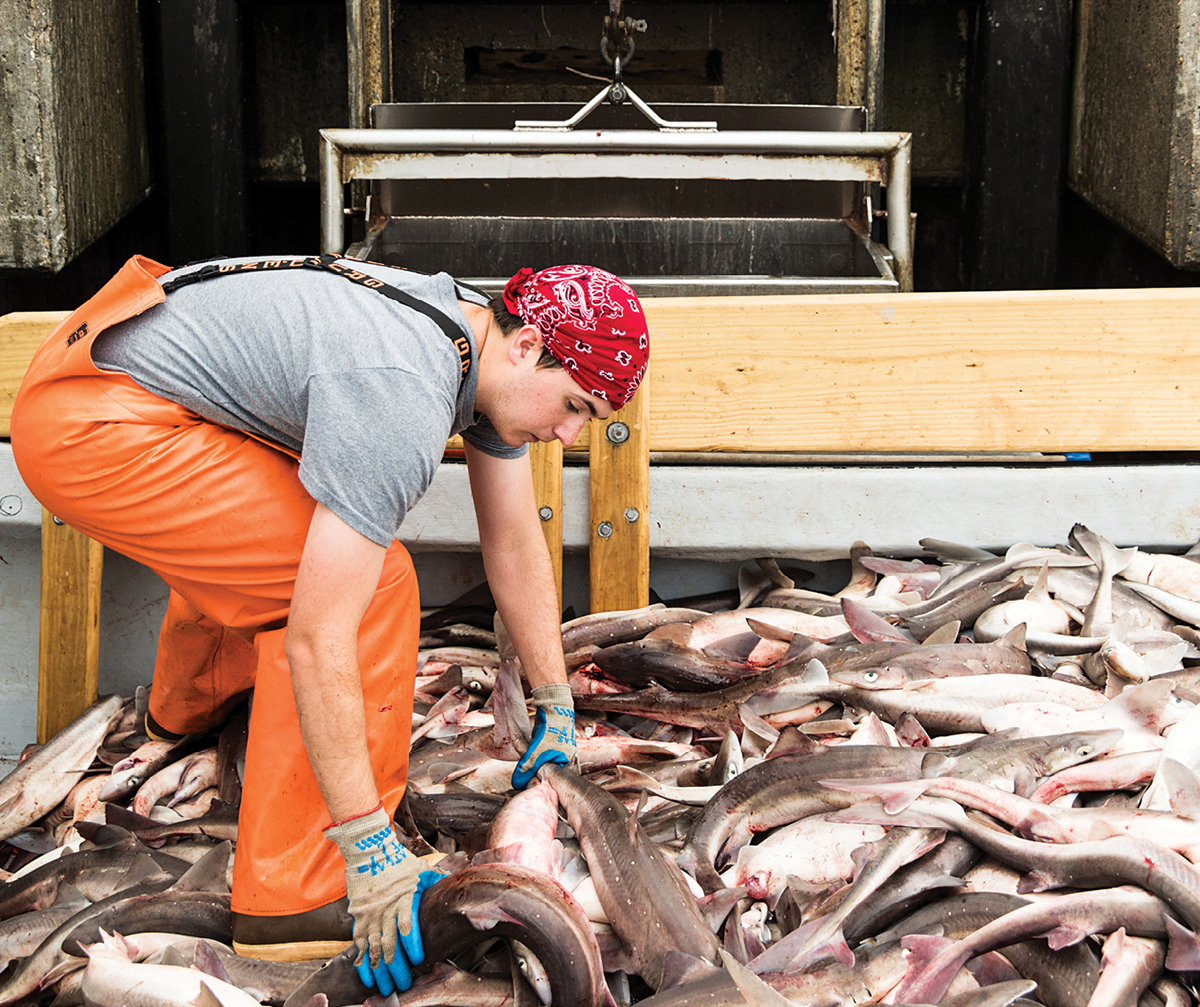
Mitchell Kelleher, 19, sorts through an ankle-deep pile of dogfish at the Chatham fish pier. / Photograph by Greta Rybus
The alliance soon had ample support to give. In 2014 the University of New England, in conjunction with the alliance, received a quarter-million-dollar grant from NOAA to study dogfish-market development. Most of their early efforts centered around the culinary scene. Chefs such as Carolyn Johnson, of Concord’s 80 Thoreau, and William Kovel, of Cambridge’s Catalyst, served dogfish pâté and spice-crusted dogfish at fancy Trash Fish Dinners. The Corner Store, a Cape Cod sandwich and burrito spot, now peddles dogfish burritos, courtesy of Doug Feeney, on Fridays in summer and fall. The way boosters see it, restaurants serve as crucial beachheads in the war for the American diner. “People are more willing to order something unfamiliar off a menu from a chef they trust than bring it home from a fish counter,” says Jen Levin, the sustainable seafood program manager at the Gulf of Maine Research Institute.
But while gourmet restaurant preparations might win hearts and minds, they can’t support fisheries on their own. The Corner Store, for instance, sells around 30 pounds of dogfish each week; during the dogfish season, by contrast, fishermen are each allowed to catch 5,000 pounds each day. “Only volume can save this fishery,” Feeney claims. “I don’t need orders you can measure in pounds—I need orders you can measure in metric tons.”
That kind of volume can come only from massive buyers, such as hospitals, universities, and military bases. At those institutions, the nondescript cafeteria fillet is often pangasius, a Southeast Asian catfish. And it’s those institutions that dogfish advocates have been most eager to court. Feeney has filleted dogfish for tastings at Harvard and UMass Amherst; has sold his smallest dogs, called “whips,” to a Wisconsin lab that supplies dissection samples to biology classes; and is trying to launch a dogfish processing co-op that would guarantee local fishermen a fair price for their catch. “I don’t look at dogfish as trash,” says Greg Walinski, a longtime cod fisherman who increasingly relies on the dogs. “They’re too important.”
Dogfish fans claim the species is approaching critical mass. “Thirty years ago nobody knew what calamari was, and now every bar in the world sells calamari,” Jared Auerbach says. Yet the species hasn’t yet gone mainstream. Although Auerbach sells haddock, flounder, and other whitefish to universities and hospitals, few of those buyers have yet accepted dogfish. And despite lobbying from New England lawmakers and fishing groups, the U.S. Department of Agriculture declined to make a bulk purchase that would have placed dogfish everywhere from food pantries to school lunchrooms. Dogfish might be on the cusp, but the dominoes haven’t quite toppled.
That sluggish progress has Feeney, like many shrewd American entrepreneurs, looking to China. In May 2015 Feeney and Auerbach enticed a consortium of Chinese seafood buyers to visit Chatham and hear their dogfish pitch. Feeney later buttered them up at a Red Sox game, where the beer flowed freely and everyone left Fenway with giant foam fingers.
Six months later Feeney flew to Qingdao for Asia’s largest seafood exhibition. He set up a booth overflowing with monkfish, mackerel, skate wings, and, of course, dogfish, and wore his red Grundens bib pants after he heard the Chinese associate the color with prosperity. He hollered a cheerful “Ni hao!” to everyone who passed and sang Beach Boys songs in vast karaoke rooms with his local hosts. Though he left without a deal, he sensed China’s potential. We Americans are milquetoasts in our seafood preferences, uninterested in anything more exotic than mild fillets; the Chinese, by contrast, are intrepid eaters from the waste-not, want-not school. In China, Feeney says, each dogfish contains six separate products, from its skin to its liver. Here, at last, were his metric tons.
Of course, it’s hard to overlook the irony of a Cape Cod fisherman peddling American fish to China, even as Chinese tilapia floods the United States. “I’d much prefer to keep our product local,” acknowledges Auerbach, who helped fund Feeney’s trip. “But the goal is to sustain the livelihood of the small-boat American fisherman. If that means selling to China, then we’re selling to China.”
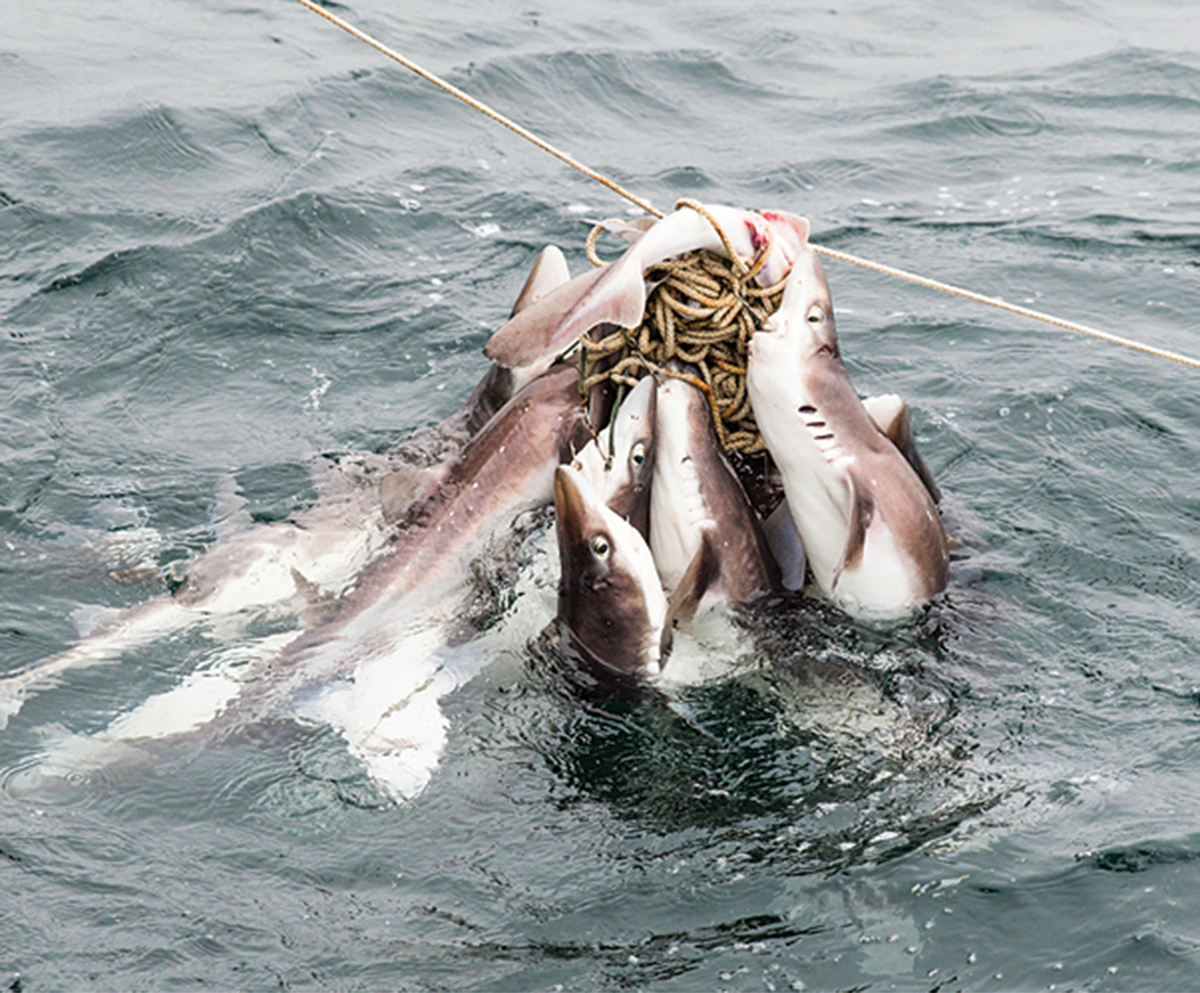
Dogfish take the bait. / Photograph by Greta Rybus
Back on the Noah, the afternoon has taken on a Murphy’s Law quality, checkered with minor accidents. A long line snags on submarine garbage, and the hauler breaks down. Between the lost gear and the lost time, Feeney catches only half of his 5,000 permitted pounds. At the Chatham pier, he pulls the Noah snug against the dock. Though most of his dogs will end up shipped to New Bedford and, eventually, Europe, Feeney sets aside the choicest specimens for the Corner Store. He slices the sharks along the belly and flings the guts into the harbor, where fat seals scarf down the scraps. A few embryonic pups, still attached to their golden egg sacs, slide around the deck.
Elderly tourists lean over a wooden railing, cameras whirring, entranced by the boat and the gulls and the goateed guy with his catch, a Winslow Homer painting come to life. “Excuse me, but what kind of fish is that?” one onlooker asks.
“Dogfish,” Feeney sighs. He’s been awake since 4 a.m.; he looks beat.
The tourist gapes. “Dogfish?”
“Dogfish,” Feeney confirms, turning back to his task. Suddenly, though, his face softens, and he seems to remember his ambassadorial role. “Nice white fillet, delicious fish,” he says, warming to his favorite subject. “Anything you can do with cod, you can do with dogfish. Certified sustainable. Caught local, right here in Chatham. Crazy fresh.” He pauses. “You ever hear of cape shark?”
The term “cape shark” is the latest marketing weapon in the arsenal of Feeney and the alliance, a neologism approved for use by the FDA in 2015. The unsavory moniker “dogfish,” and its connotation of frying up Fido, had always been accused of stunting sales. (Never mind that diners seem to harbor no misgivings about chowing down on catfish.) The rebranding’s timing was fortuitous: Great white sharks, once persecuted, were recolonizing Cape Cod’s waters, and locals were buzzing about the comeback. Sharks had captured the zeitgeist. The Corner Store named its dogfish burrito a “SharkRito,” and the Ipswich Shellfish Group created “Shark Bites,” baked nuggets coated in gluten-free batter.
The cape shark campaign highlights dogfish’s promise—and, perhaps, its risk. Renaming seafood is a well-worn strategy: Witness the little-known Patagonian tooth fish, which became a white-hot global commodity after American buyers dubbed it Chilean sea bass. In that case, economic success spawned ecological disaster, as a rush of overfishing and poaching pushed the tooth fish into steep decline. Closer to home, monkfish stocks are just now recovering after a similar market-driven boom and bust.
Sharks, too, come with their own environmental baggage. As many as 100 million are hauled from global oceans every year, many victims of “finning,” a wasteful practice in which fishermen lop off sharks’ fins—a delicacy in China—and discard their still-living bodies. (Finning is illegal in American waters, and Massachusetts law prohibits the possession or sale of fins, though dogfish are exempt.) An estimated quarter of the world’s sharks and rays are at risk of extinction.
Of course, not all sharks are equally imperiled. While some species, like the scalloped hammerhead, face immediate danger, the Marine Stewardship Council has certified the East Coast dogfish industry as sustainable. “I can’t say it’s a perfect fishery, but this is one of the best examples we have of demonstrating recovery of a heavily fished shark population through management,” says Sonja Fordham, founder and president of Shark Advocates International. Still, Fordham is not resting easy. Although the fishery is sustainable for now, the shark’s long gestation period will always convey some risk. What happens, she wonders, when domestic and foreign markets expand? “It’s easy to follow the scientific advice when you’re not catching your quota,” Fordham cautions. “I can’t say it’s worry-free if markets start to change.”
The dogfish revolution has another major hurdle to overcome: mercury. The Massachusetts Department of Public Health cautions pregnant women and young children against consuming sharks. A 2014 study found that around one-third of a sample of Rhode Island spiny dogfish exceeded 0.30 parts per million of mercury—the guideline the EPA has set for fish consumption. Other research has been slightly more reassuring: A 2015 NOAA-funded study found that winter-caught male dogfish from southern New England contain mercury levels comparable to widely consumed species such as snapper and halibut, and that other ocean dwellers are riskier propositions. “These dogfish contain less mercury than tuna and far less than swordfish, and there’s still a robust market for those fish,” asserts Adam St. Gelais, the University of New England research scientist who coauthored the study.
While dogfish aren’t completely without drawbacks, the diminutive sharks appear unusually resistant to at least one threat: climate change. Global warming and shifting currents are heating up the northwest Atlantic four times faster than the worldwide ocean average, driving ecosystems haywire. Migrating right whales have veered off course; puffins have starved; shrimp have vanished. The heat may also help explain why conservation laws haven’t revived cod, a cold-water-loving species living near the southern fringe of its range in Massachusetts. By contrast, dogfish—undiscriminating predators equally at home in North Carolina and Newfoundland—appear well adapted to our warm new world. “They’ve got ranges of almost 20 degrees Celsius,” says marine biologist James Sulikowski. “Climate change—dogfish don’t know or care what that is.”
Add it all up, and dogfish seem in some ways the perfect modern fishery: temperature-proof, local, and, at least for now, well managed. To Feeney and the alliance, they are CPR for floundering commercial fishermen on the Cape, a reset button for the fisheries managers who allowed cod to collapse. The history of commercial fishing is littered with stories of depletion; whether dogfish represent a sustainable new chapter depends largely on whether fishermen, scientists, and conservationists can set aside old grievances and work together. “We’re sort of where the U.S. auto industry found itself in the ’70s and ’80s,” says John Pappalardo. “We’ve got to retool ourselves, reimagine our place in the world, move beyond old practices and beliefs. It’s time for a new playbook.”
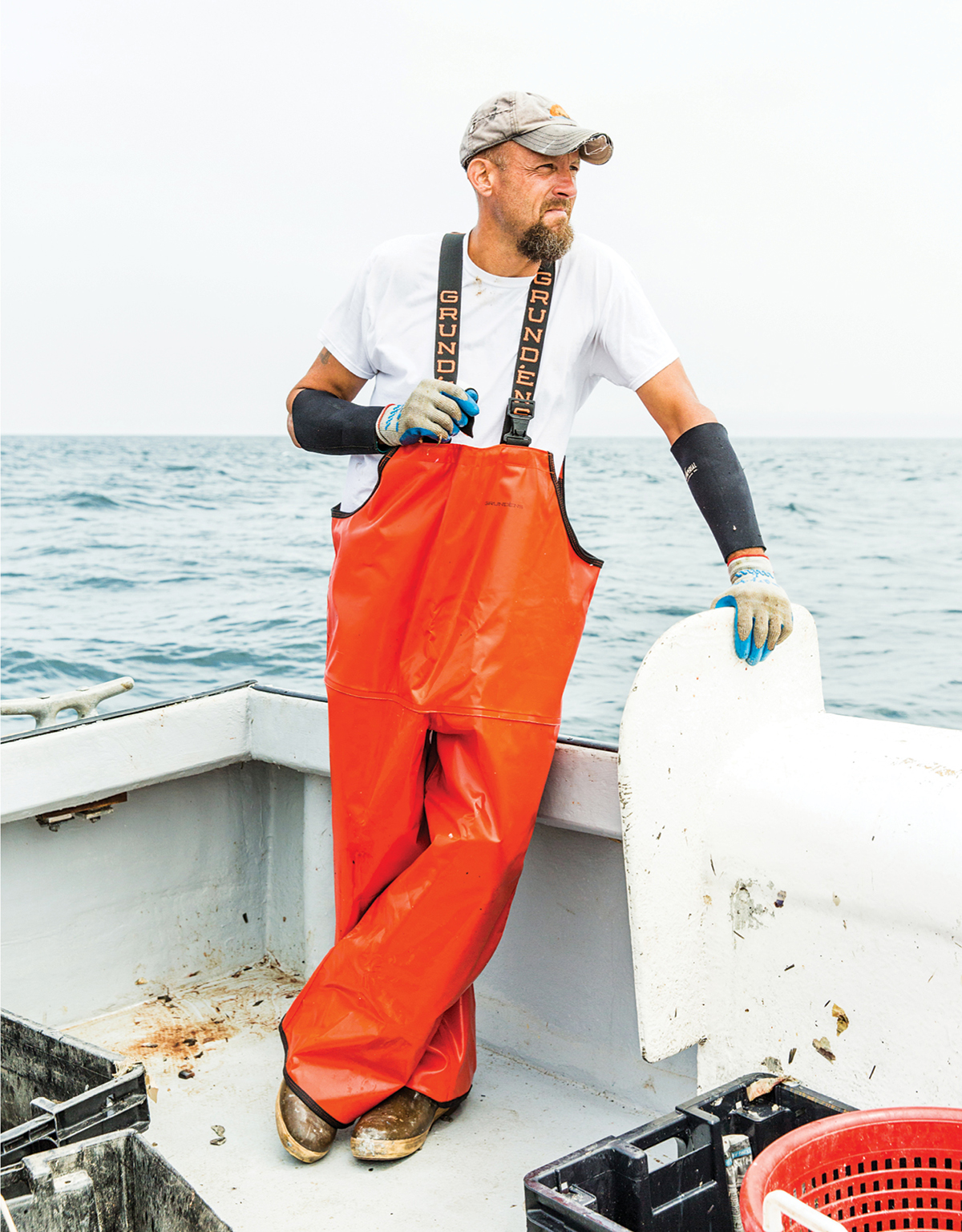
“I have my whole livelihood on the line here,” says fisherman Doug Feeney of his dogfish venture. / Photograph by Greta Rybus
If the United Nations hosted a fish market, it would resemble the Seafood Expo North America. On a blustery March afternoon, the hangarlike Boston Convention & Exhibition Center is packed with booths vending a cornucopia of seafood: South African hake, Icelandic salmon, Korean fish balls of unclear provenance. Flounder and lobster bob lazily in tanks; oysters and scallops glitter atop ice. Suit-clad Chinese businessmen huddle with unshaved Alaskans, and leggy models distribute plastic spoons heavy with smoked salmon. It’s a chaotic scene, redolent of saltwater and money.
At noon, Feeney and the rest of the alliance’s dozen-person delegation adjourn to Row 34, a capacious South Boston seafood restaurant where the alliance is hosting an elaborate dogfish lunch. A course of dogfish fritters precedes pan-seared dogfish and beer-battered dogfish and chips, all of it moist, white, and inoffensive. To the untrained palate it could be cod. Nick Muto, a bearded fisherman with a cinderblock physique, flakes off a forkful. “In uncertain times, it’s something you can count on,” he says. “Skates and dogs—that’s your foundation. You’re not gonna get rich; you gotta grind it out.” The butterscotch pudding dessert arrives, mercifully dogfish-free.
While plenty of Massachusetts chefs are experimenting with dogfish, not everyone in the seafood industry is enamored with cape shark. After lunch at Row 34, Muto and other alliance members return to the convention to meet with representatives from a Canadian seafood distributor. Though Nancy Civetta, the alliance’s communications director, had sent the distributor a case of dogfish samples, the Canadians hadn’t been interested. “It’s a relatively firm fish with a mild flavor,” opines the rep, a gray-haired man in a navy suit. “But when the consumer doesn’t know what something is, then you have to spend more on marketing.” He’d given samples to his girlfriend and her parents, native Bostonians. “They said, ‘Nobody eats that.’”
There’s a long, slightly uncomfortable pause, as though the Canadian has just insulted a family member. The buyer and Civetta go back and forth for a few minutes, discussing fishing techniques, seasonal availability, and value-added products. Civetta mentions Shark Bites and the buyer perks up. “That’s got a ring to it,” he says. They talk marketing, Civetta describing the promotional videos the alliance has compiled, and the Canadian nods thoughtfully. “We wouldn’t be averse to trying it again,” he says finally. “I know what we’re going to struggle with, though: the name.”
“How about Chatham sea bass?” Muto quips, and everyone laughs.
For Feeney and his family, the future rests largely on whether such large-scale buyers, and the customers they represent, can be persuaded to bite. At day’s end, long after most conventioneers have dispersed for happy hour, Feeney reappears at the Red’s Best booth, where Jared Auerbach has assembled a small tower of monkfish and striped bass. Feeney has spent the afternoon schmoozing a Chinese buyer—his white whale—and he has the keyed-up aspect of a gambler who’s just stepped away from a blackjack table. “There are a million people here with farmed salmon and tilapia,” he says with disgust. “You know how you’re raking the yard sometimes and all the dust comes up and gets in your mouth? That’s what tilapia tastes like. Actual dirt.”
Still, he’s in a good mood—the Chinese buyer is interested, and he’s closing in on a deal. “Banner day. Phenomenal,” he says, rubbing his hands together. “The fire’s been lit, can’t put it out now.” He grins slyly. “We gotta kick tilapia in the balls.”


